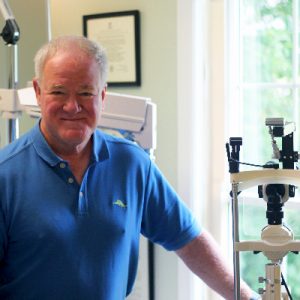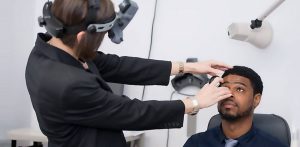There are many timeless myths around eye health— but discerning fact from fiction is essential to understanding the path to better eye health.
According to the Centers for Disease Control and Prevention (CDC), approximately 93 million adults in the United States are at high risk for serious vision loss, and 6.8% of children under the age of 18 have a diagnosed vision disorder.
With so many people experiencing vision issues, it’s no wonder so many myths are floating around about how to protect your eye and vision health.
Here are 8 most frequent vision and eye health myths…busted!
Myth 1: Having 20/20 vision means your eyes are perfectly healthy.
Fact: A person with ‘perfect’ 20/20 vision has clear central vision, but they can still have a host of eye and vision problems that can impact the health of their eyes.
While 20/20 vision is important, it is nowhere near the whole picture.
A person can have a potentially dangerous eye disease, such as glaucoma, retinal disease and corneal conditions and still have 20/20 sight.
Sight loss from these and other serious conditions is often not noticeable until the eye is permanently damaged and vision loss has occurred.
Having 20/20 vision also does not ensure the mastery of visual skills like convergence and divergence, visual tracking and accommodation. All of these skills and more are necessary for success in work and school.
A comprehensive eye exam with your local eye doctor will check for all necessary vision skills, and test for warning signs of eye disease.
Myth 2: Eyeglasses and contact lenses weaken the eyes.
Fact: Research shows that optical corrections are essential for clear vision and will not worsen the optical prescription.
Eyeglasses worn to correct refractive errors such as astigmatism, presbyopia, hyperopia (farsightedness) or myopia (nearsightedness) do not weaken your eyes.
You might enjoy the benefits of clear and comfortable vision and use your glasses or contact lenses more often, but they will not weaken the eyes.
A person’s eyes change as they get older, and this can result in changes in their vision even if their eyes are perfectly healthy.
If you do experience a worsening of your vision, see your eye doctor immediately as an eye condition, injury or disease could be the cause requiring medical attention..
Myth 3 : If you cross your eyes, they may stay that way permanently.
Fact: Permanently crossed eyes do not occur as a result of a person with a healthy ocular system consciously crossing them.
Rather, crossed eyes occur as a result of eye conditions such as eye turns (strabismus) or lazy eye (amblyopia).
If you notice a child with a crossed eye, it may be a result of nerve or muscle damage from injury or disease.
Conversely, strabismus and similar conditions that cause crossed eyes do not go away spontaneously. With assistance from an eye doctor, and often with commitment to a thorough vision therapy plan, these conditions can be addressed and, in many cases, completely reversed.
These issues usually show up in childhood, and are easier to treat the sooner they are detected. This is why it is so important to ensure your child has regular eye exams.
SEE RELATED: 15 Actions that Impact Your Eye Health
To learn more about how best to take care of your long-term eye health, contact your local eye doctor.
Myth 4: Vision loss is unpreventable.
Fact: Almost 80% of vision loss can be prevented by early detection and treatment.
Your optometrist has the training and equipment to help maintain your eye health by predicting, diagnosing and minimizing the loss of vision.
Additionally, if you’re experiencing any changes to your vision, such as blurry vision, large floaters in your vision, flashes of light, eye pain or difficulty in your central or peripheral vision, your eye doctor will be able to take a look and see what the problem is and how to treat it.
Many serious eye conditions, such as glaucoma, rarely display obvious symptoms before permanent eye damage has already occurred.
Regular routine comprehensive eye exams are your best bet for catching and treating these diseases before they can cause lifelong damage to your vision.
Myth 5: Myopia progression is unavoidable for myopic children.
Fact: Optometrists can provide evidence-based treatment options, known as Myopia Management, which can slow down or even stop your child’s myopia from worsening.
However, during the past several years many new innovations and advancements have been made in the field of myopia control, and it is increasingly possible to slow or even prevent the development of myopia in children.
The results of a clinical trial, published in JAMA Ophthalmology (September 2015) showed that playing outside for 30-40 minutes a day can result in a significant drop in a child’s risk for developing myopia.
For those who already have myopia, specific multifocal eyeglass lenses and contact lenses have been shown to significantly slow progression.
Ortho-k contact lenses and low-dose atropine eye drops have also shown similar results.
Myth 6: Reading in poor light will hurt your eyes.
Fact: Although you may experience headaches or eye strain from the extra effort of reading in poor lighting conditions, there is no scientific evidence to suggest that reading in this type of setting does any damage to your eyesight.
For hundreds of years, the majority of reading and other work at night was done by moonlight, candlelight or gaslight.
During all that time, refractive errors such as myopia were no more prevalent than they are today. Quite the opposite. For various reasons, the incidence of myopia is actually higher today than it was back then.
Myth 7: You can permanently damage your eyes by wearing eyeglasses that are too strong.
Fact: Having a prescription that is too strong, too weak or otherwise wrong for you can cause headaches, nausea and eyestrain, but it cannot do long-term damage to your vision and eye health.
Eyeglasses change the way light rays are refracted as they reach your eye. They don’t directly interact with or change any part of your eye.
Nonetheless, if your eyeglass or contact lens prescription is causing you discomfort, and you feel it’s incorrect, you should contact your eye doctor as soon as possible to have it corrected.
Myth 8: Sitting too close to the TV can damage your eyes.
Fact: Contrary to popular belief, sitting too close to the TV could be a sign of nearsightedness, rather than the cause of it.
When it comes to sitting too close to the TV or other electronic screens, people tend to confuse which is the cause and which is the effect. Sitting too close to the screen is still not advisable, as it can cause symptoms such as headaches and eyestrain.
LEARN MORE: Guide to Eye Health
Make an appointment with an eye doctor near you to find out how to best maintain your long-term eye health and clear vision.
Here we bust the 8 most frequent vision and eye health myths.
Discerning fact from fiction is essential to understanding the path to better eye health.










